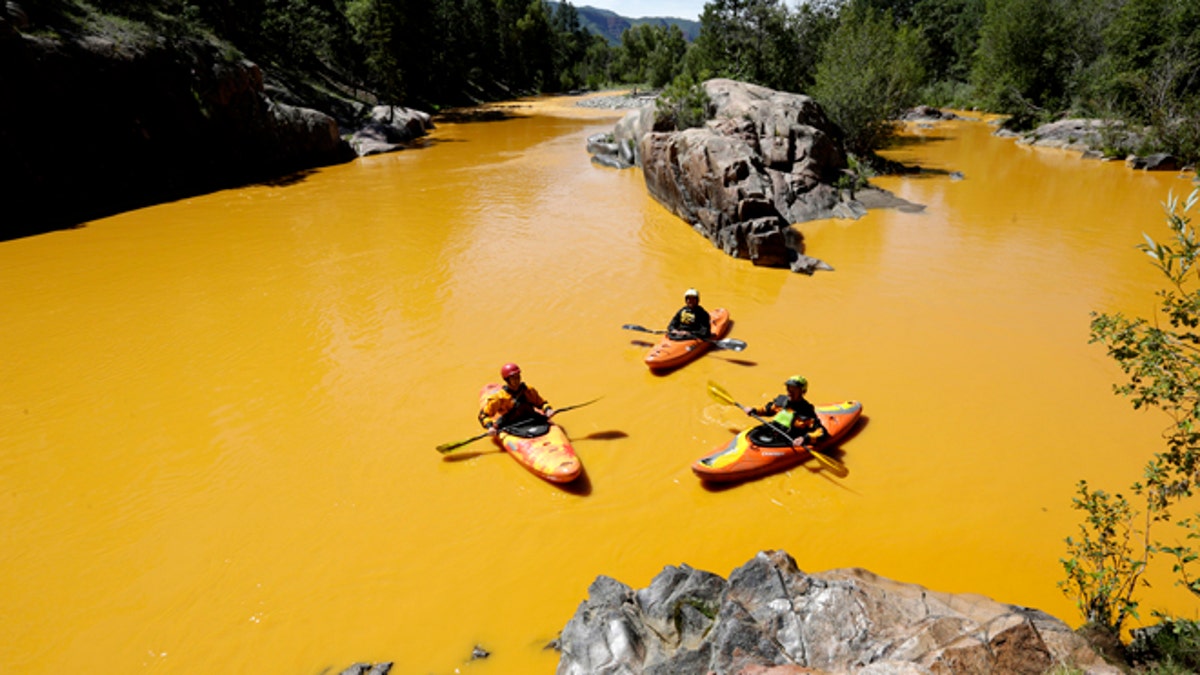
In this Thursday, Aug. 6, 2015 file photo, people kayak in the Animas River near Durango, Colo., in water colored yellow from a mine waste spill. A crew supervised by the U.S. Environmental Protection Agency has been blamed for causing the spill while attempting to clean up the area near the abandoned Gold King Mine. Tribal officials with the Navajo Nation declared an emergency on Monday, Aug. 10, as the massive plume of contaminated wastewater flowed down the San Juan River toward Lake Powell in Utah, which supplies much of the water to the Southwest. (Jerry McBride/The Durango Herald via AP, FILE)
The Mexican government said that the toxic wastewater currently surging downstream through the southwestern United States poses no threat to the country.
The office of the Federal Attorney for Environmental Protection (Profepa) said that while Mexico faces no risk from the 3 million gallons of toxic material accidentally spilled into Colorado's Animas River by workers for the U.S. Environmental Protection Agency (EPA), it is closely monitoring the wastewater as it makes its way south toward the Colorado River.
The spill occurred on Aug. 5 when an EPA-supervised crew accidentally unleashed the water from the Gold King mine near Silverton, Colorado. The breech sent a wave of yellow-colored, metal-laden water into the Animas and San Juan rivers. The toxic plume has passed through parts of Colorado, New Mexico, Utah and the Navajo Nation.
The San Juan River is a major tributary of the Colorado, one of the largest rivers in the Western United States that empties into Mexico's Gulf of California.
EPA administrator Gina McCarthy said her agency took full responsibility for the spill and that she had ordered agency personnel across the country to cease field work on abandoned mines while the spill was investigated. EPA officials said they are seeking details on what the stop-work order means.
The Gold King leak was proving devastating to the Navajo Nation, which recently negotiated a settlement giving it rights to water from the San Juan River. The tribe plans to build a $20 million water treatment plant in northwestern New Mexico to take in the extra volume of water granted to the settlement and to provide a clean source of drinking water to the 16,000 families on the tribal lands who lack running water.
Heavy metals already were present in the Navajo's underground aquifer, and "now those same things are dumped in the river," complained Rex Kontz, deputy general manager for the Navajo Tribal Utility Authority. He said meeting EPA standards for clean drinking water could double the plant's cost and require millions more in operating costs each year.
The EPA said it will be Monday at least, before test results can help show what hazardous materials are in the water, although it could take weeks longer. The higher the concentrations, the higher the cost of removing heavy metals. And unlike some other Native-American tribes, the Navajo are not flush with casino revenues.
"This new water coming in was the avenue to creating new development and creating long-term sustainability," Kontz said. "Now it's almost like your legs were cut out from under you."
While the plume makes its way through New Mexico, the governor of neighboring Utah, Gary Herbert, has declared an emergency for the parts of the state that are being affected.
Herbert says the designation will help free public money to help people and businesses in southern Utah who depend on water from the San Juan River deal with the long-term effects of contamination.
Utah officials said Wednesday that weekend tests showed the presence of metals in the state's river water, but the plume has since lost its distinctive yellow color.
The Associated Press contributed to this report.
